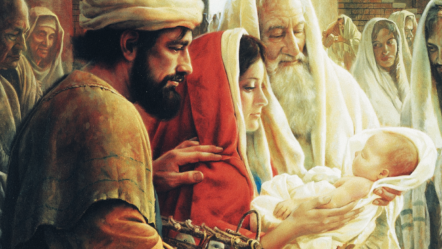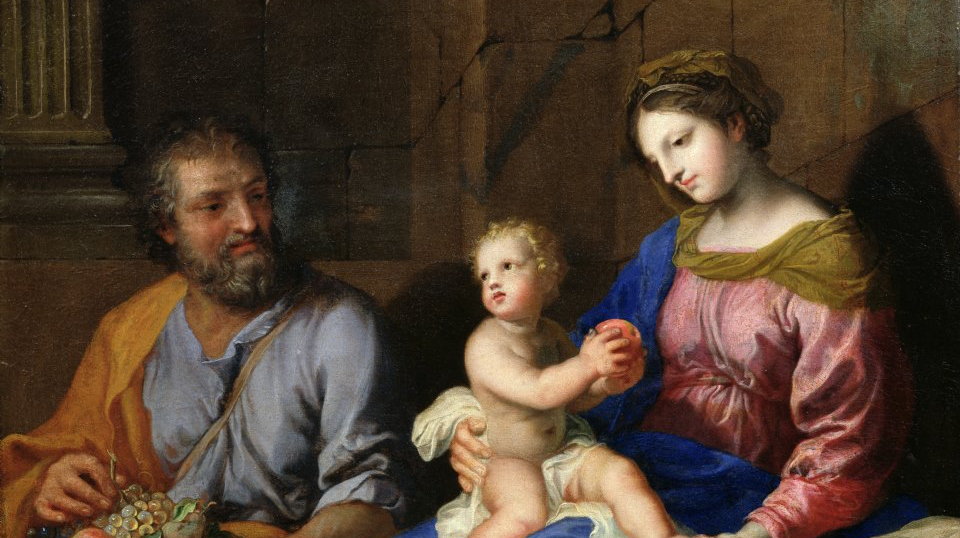I don’t know about you, but whenever I think of the Holy Family, I’m drawn to images painted by great artists. Most depict Mary, Joseph, shepherds, and animals surrounding the infant Jesus. For me, I also like to envision Mary and Joseph holding Jesus in their arms. As they gaze at Him and hold Him close, they not only hear him breathe, but actually, feel it; baby’s breath, if you will. To rework an old saying from an automotive legend: “In life, if you can find a better experience, take it.”
A priest once told me a story of being invited to the home of a young couple shortly after the birth of their newborn baby. Upon arriving, he was greeted by the proud parents who immediately asked if he would like to hold their baby. And, of course, he said—yes! Throughout his hour-long visit, he held their tiny infant in his arms while they conversed about their experience as new parents. As he departed, he thanked them and left their company with a smile that stretched from head-to-toe. Later that week, following Sunday Mass, he told me that they approached him and thanked him for visiting but then apologized: “Father, in our excitement, we forgot to offer you coffee.” To which the priest replied: “At the parish, there is plenty of coffee, but the opportunity to hold your baby in my arms turned out to be the blessing of my day.”
In the Gospel of Luke (2:22-40), Mary and Joseph bring the infant Jesus to the Temple so that he might be consecrated according to the custom of Jewish Law. For Simeon, this visit was the moment that had been promised him (by the Holy Spirit) for a lifetime; that, before his death, he would hold in his arms the promised Messiah of Israel.
For Simeon, holding Jesus most assuredly brought both tears of joy and a smile to his face. This devoted servant of God then speaks what has come to be known as Simeon’s Canticle, which theologians note contains two stanzas: first, an act of thanksgiving to God, for, with profound joy, he has seen the Messiah; the second is prophetic and focuses upon the blessings that Jesus will bring to all people as well as preparing Joseph and especially Mary for that which will transpire during the earthly life of their newborn son.
On this Feast of the Holy Family of Jesus, Mary, and Joseph, it is interesting that in Sacred Scripture, little information is provided us regarding Jesus’ family life. In chapter two of Luke’s Gospel, we find: the story of Jesus’ birth; the Visit of the Shepherds; Jesus’ Circumcision; the Presentation of Jesus in the Temple; and the story of Mary and Joseph “losing” the child Jesus and “finding” him in the Temple. And then, in chapter three, Luke moves toward the preaching of John the Baptist, Jesus’ baptism, and the beginning of His three-year ministry that leads to Calvary.
Now in our day, when reflecting upon the Holy Family, there is a temptation to think of them as smiling figures on Holy Cards that we carry in our purses or wallets. By doing so, however, we might imagine them as immune to human struggles. But, this is not true. In Mary’s case, she would experience the death of Joseph and, as Simeon prophesied, knew that the future for Jesus and herself would contain the greatest of agonies.
But despite the struggles of the Holy Family, we know that there was love. After all, how could there not be? For Jesus is— Love. He is the love promised by the prophets that would enter our midst to love us, show us how to love others, and save us from our sins.
So, we wonder, just what constitutes a Holy Family? The answer is simple: sacrificial love. For it is sacrificial love that transforms our families into holy families! And, it is in the context of the family that we learn to move outside of ourselves and our own cocoons, so that we might care for others. It is within the family where moms, dads, grandparents, aunts, and uncles learn to “do without.”
Our ideas of family can differ, too! My favorite story of broadening things up a bit involves the story of a monk named Thomas Merton who, while in downtown Louisville, at the corner of Fourth and Walnut, had what is now called his Fourth and Walnut moment. He recalled that “…standing there in the center of the shopping district, I was suddenly overwhelmed with the realization that I loved all those people, that they were mine and I theirs, that we could not be alien to one another even though we were total strangers.”
Venerable Bishop Fulton J. Sheen once said this about sacrificial love: “The divine love is sacrificial love. Love does not mean to have and to own and to possess. It means to be had and to be owned and to be possessed..It is arms outstretched to embrace all humanity within its grasp.”
All of this mirrors—perfectly— the sacrificial love on display within the Holy Family of Jesus, Mary, and Joseph: the way Mary sacrificed for Jesus and Joseph; the way Joseph sacrificed for Jesus and Mary; and the way Jesus sacrificed for all of us!
Sacrificial love is the love that Jesus gives—and it is learned in the family. Sacrificial love is true love, divine love. And the more we practice and perfect it, the more we become holy families.







